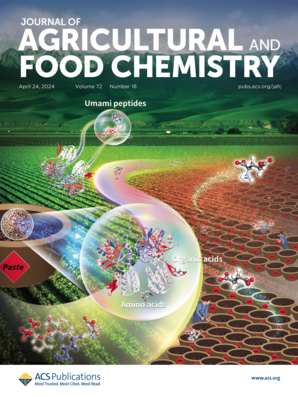活细菌的化学蛋白质组学鉴定了表没食子儿茶素-3-没食子酸酯(EGCG)的共价相互作用组及其多模式抗菌机制。
IF 6.2
1区 农林科学
Q1 AGRICULTURE, MULTIDISCIPLINARY
引用次数: 0
摘要
表没食子儿茶素-3-没食子酸酯(EGCG)是绿茶中最具生物活性的儿茶素,对多种细菌(包括多重耐药菌株)具有显著的抗菌活性。然而,其精确的分子靶点和作用机制仍然知之甚少。在此,我们设计了一种基于EGCG可点击和细胞渗透性活性的探针YnEGCG,通过原位化学蛋白质组学全面研究其分子靶点。YnEGCG使活大肠杆菌中共价相互作用蛋白的荧光可视化和质谱鉴定成为可能。定量蛋白质组学鉴定了600多个蛋白质,其中约10%表现出非常高的富集(H:L bbb50)。这些包括关键的细菌酶,如DNA回转酶、DNA聚合酶、ATP合酶、核糖体蛋白等,以及一些以前未发现的靶标。此外,我们通过实验验证了EGCG抑制DNA旋切酶活性以及从头合成蛋白质。综上所述,我们的原位化学蛋白质组学研究表明,EGCG与关键的细菌酶结合,揭示了以前未知的抗菌靶点,并提供了对其广谱作用的见解。本文章由计算机程序翻译,如有差异,请以英文原文为准。
Chemoproteomics in Live Bacteria Identifies Covalent Interactome of Epigallocatechin-3-Gallate (EGCG) Underlying Its Multimodal Antibacterial Mechanism.
Epigallocatechin-3-gallate (EGCG), the most bioactive catechin of green tea, exhibits remarkable antibacterial activity against a wide range of bacteria, including multidrug-resistant strains. However, its precise molecular targets and mechanisms of action remain poorly understood. Herein, we have designed YnEGCG, a clickable and cell-permeable activity-based probe of EGCG, to comprehensively investigate its molecular targets through in situ chemoproteomics. YnEGCG enabled the fluorescence visualization and mass-spectrometric identification of covalently interacting proteins from live E. coli. Quantitative proteomics identified over 600 proteins, with approximately 10% exhibiting remarkably high enrichment (H:L > 50). These included critical bacterial enzymes such as DNA gyrase, DNA polymerase, ATP synthase, ribosomal proteins, etc., and several previously unidentified targets. Further, we experimentally validated that EGCG inhibits DNA gyrase activity as well as de novo protein synthesis. Taken together, our in situ chemoproteomics studies revealed that EGCG binds to critical bacterial enzymes, uncovering previously unknown antibacterial targets and providing insights into its broad-spectrum action.
求助全文
通过发布文献求助,成功后即可免费获取论文全文。
去求助
来源期刊
CiteScore
9.90
自引率
8.20%
发文量
1375
审稿时长
2.3 months
期刊介绍:
The Journal of Agricultural and Food Chemistry publishes high-quality, cutting edge original research representing complete studies and research advances dealing with the chemistry and biochemistry of agriculture and food. The Journal also encourages papers with chemistry and/or biochemistry as a major component combined with biological/sensory/nutritional/toxicological evaluation related to agriculture and/or food.

 求助内容:
求助内容: 应助结果提醒方式:
应助结果提醒方式:


